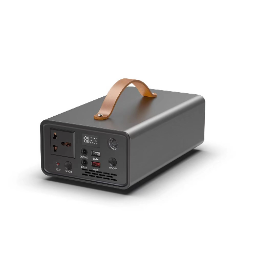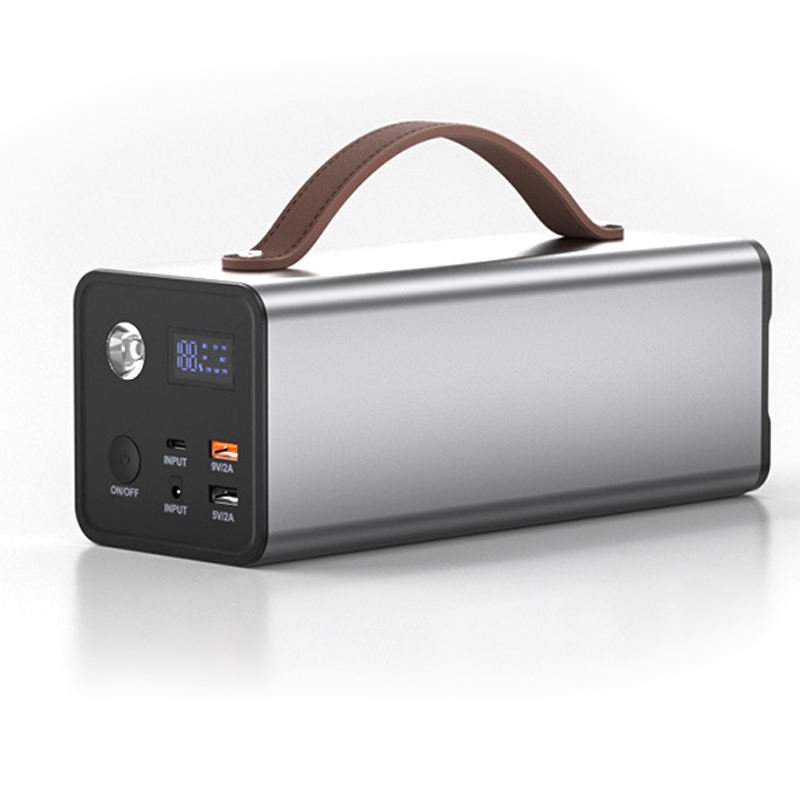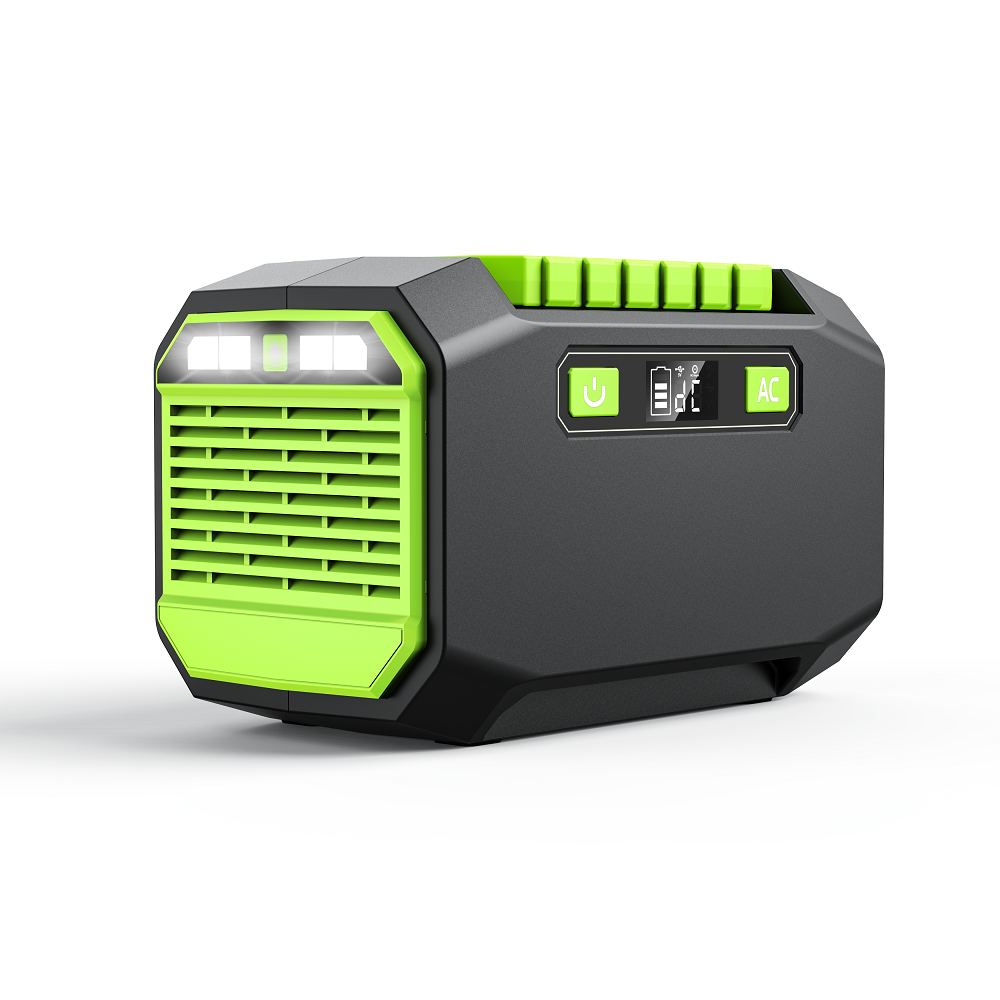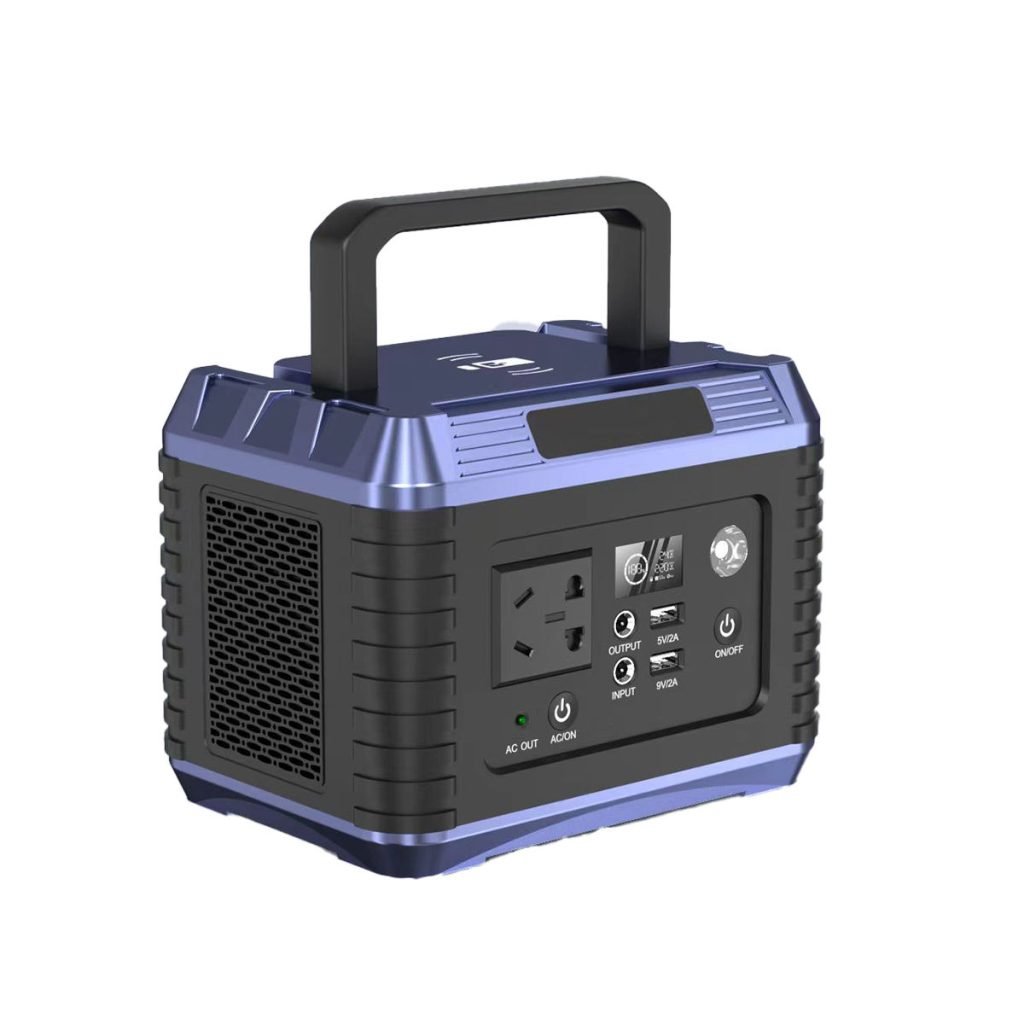Portable power stations are rechargeable battery-powered devices that provide electrical power on the go, ideal for camping, emergencies, or off-grid activities. Their core function is to store energy and supply it to various devices, acting as a portable outlet.
The battery type determines the station’s performance, weight, and user experience. A lighter battery makes the station more portable, while a high-capacity battery extends the device runtime. Faster charging, longer lifespan, and maintenance requirements are all affected by the battery technology.
The illustration showcases the different types of batteries used in portable power stations, including Lithium-ion, LiFePO4, and Lead-acid batteries.
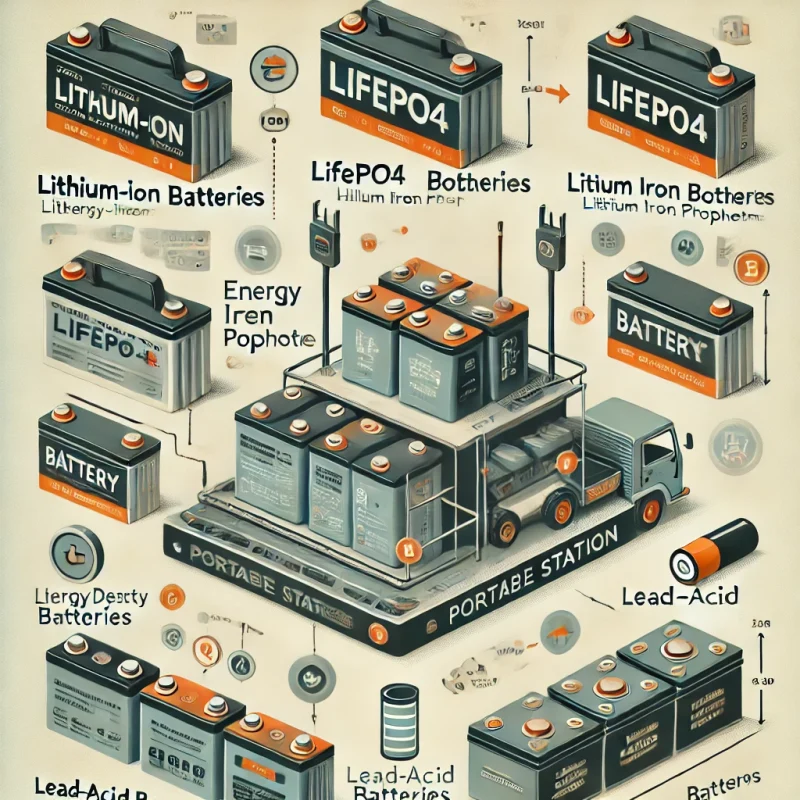
The two primary battery types are Lithium-ion and Lead-acid:
- Lithium-ion (Li-ion): Lightweight, has a longer lifespan and higher energy density, but is more expensive.
- Lead-acid: Cheaper, heavier, shorter lifespan, and requires maintenance.
Overview of Battery Types in Portable Power Stations
The battery is the core component of a portable power station, responsible for storing electrical energy that can be used to power devices when needed. The size and type of battery determine how much energy can be stored (measured in watt-hours, Wh) and how long the station can provide power. The performance of a portable power station is directly tied to the battery’s capacity, efficiency, and rechargeability. A higher-capacity battery allows for longer runtimes and the ability to power more demanding devices. In contrast, the battery’s efficiency affects how much of the stored energy is available for use. The battery’s charge cycle lifespan also impacts the overall durability and longevity of the power station.
| Feature | Lithium-ion | Lead-acid |
|---|---|---|
| Weight | Lightweight, easy to carry | Heavier and bulkier |
| Energy Density | High (more power in a smaller size) | Lower (requires more space for power) |
| Lifespan | 500-2000+ charge cycles | 200-500 charge cycles |
| Cost | Higher upfront cost | Lower initial cost |
| Maintenance | Maintenance-free | May require regular maintenance (for flooded lead-acid) |
| Charging Speed | Fast charging capability | Slower charging time |
| Portability | Highly portable, good for frequent travel | Less portable, better for stationary use |
| Environmental Impact | Fewer replacements, lower impact | Requires more frequent replacements |
| Applications | Best for frequent use and portability | Ideal for budget-conscious or backup systems |
Lithium-ion Batteries
| Aspect | Details |
|---|---|
| Definition | Rechargeable energy storage systems that use lithium ions to store and release energy. |
| Efficiency | Known for high efficiency and compact design, making them the preferred choice for many portable devices and power systems. |
| How They Work | Li-ion batteries move lithium ions between two electrodes during charging and discharging. |
| Charging Process | When charging, lithium ions move from the cathode (positive) to the anode (negative), where they are stored. |
| Discharging Process | During discharge, the ions move back from the anode to the cathode, generating electrical energy to power devices. |
| Key Advantage | The efficient movement of ions allows Li-ion batteries to deliver high amounts of energy in a small, lightweight package, making them ideal for portable applications. |
Common Uses
Li-ion batteries are widely used in:
| Common Uses of Li-ion Batteries | Examples |
|---|---|
| Consumer Electronics | Smartphones, laptops, tablets, wearable tech |
| Electric Vehicles (EVs) | Powering electric cars, bikes, and scooters |
| Portable Power Stations | Energy for off-grid solutions, outdoor activities, emergency backup systems |
Advantages of Lithium-ion Batteries
| Advantages of Lithium-ion Batteries | Description |
|---|---|
| Higher Energy Density | Lithium-ion batteries can store a large amount of energy in a compact size, allowing portable power stations to remain lightweight and deliver substantial power. |
| Longer Battery Life | Li-ion batteries typically offer 500 to 2000+ charge cycles, making them durable and suitable for frequent use over an extended period. |
| Lightweight and Portable | Much lighter than lead-acid batteries, Li-ion batteries make devices more accessible to transport, which is especially beneficial for portable power stations outdoors or on the move. |
| Faster Charging Times | Li-ion technology supports fast charging, enabling quick recharging of power stations, crucial for emergency backup and situations needing rapid power access. |
Disadvantages of Lithium-ion Batteries
- Higher Cost
- Li-ion batteries are generally more expensive than lead-acid batteries. The high cost is due to the advanced technology, longer lifespan, and better performance. However, the battery’s longevity and efficiency can offset this higher initial investment.
- Potential for Thermal Runaway
- One of the risks associated with Li-ion batteries is thermal runaway, which occurs when the battery overheats and causes a reaction to a fire or explosion. Proper battery management systems (BMS) are essential to prevent overheating and ensure the battery operates safely.
Lead-acid Batteries
What are Lead-acid Batteries?
Lead-acid batteries are rechargeable batteries that utilize lead dioxide (PbO2) as the positive electrode and sponge lead (Pb) as the negative electrode, immersed in a sulfuric acid electrolyte. They have been widely used for over a century due to their reliability and cost-effectiveness.
Overview of How Lead-acid Batteries Work
Lead-acid batteries operate through a chemical reaction between lead dioxide, sponge lead, and sulfuric acid. During discharge, the chemical reaction converts the lead and acid into lead sulfate (PbSO4) and water, releasing electrical energy. When the battery is charged, the process is reversed: lead sulfate and water are converted back into lead dioxide, sponge lead, and sulfuric acid. This reversible chemical process enables lead-acid batteries to be reused multiple times, making them suitable for various applications.
| Common Uses of Lead-acid Batteries | Examples |
|---|---|
| Vehicles | Used primarily as starter batteries in cars, trucks, and motorcycles |
| Backup Systems | Providing reliable power for uninterruptible power supplies (UPS) and emergency lighting |
| Older Power Storage Units | Used in older renewable energy systems and off-grid setups, gradually being replaced by newer technologies like lithium-ion |
Advantages of Lead-acid Batteries & Disadvantages of Lead-acid Batteries
| Advantages of Lead-acid Batteries | Disadvantages of Lead-acid Batteries |
|---|---|
| Lower Cost | Heavier and Bulkier |
| More affordable than lithium-ion batteries. | Less portable due to higher weight. |
| Proven Technology | Shorter Lifespan |
| Well-established and widely available. | Fewer charge cycles (200-500 cycles). |
| Reliable for Stationary Use | Slower Charging |
| Often used in stationary backup systems. | It takes longer to recharge compared to lithium-ion. |
| Maintenance Required | |
| Flooded lead-acid batteries may require regular maintenance. |
Comparing Lithium-ion and Lead-acid Batteries
| Comparison Criteria | Lithium-ion Batteries | Lead-acid Batteries |
|---|---|---|
| Energy Density and Portability | Wins in compactness and weight | Heavier and bulkier |
| Battery Lifespan | It offers significantly more charge cycles | Fewer charge cycles (200-500 cycles) |
| Cost Considerations | Higher upfront cost but a longer lifespan | Cheaper upfront may require more frequent replacements |
| Environmental Impact | Lower impact due to fewer replacements and higher energy efficiency | Higher impact due to more frequent replacements |
| Maintenance | Maintenance-free | It may require regular maintenance |
Which Battery Type is Right for You?
| Battery Type | Use Cases |
|---|---|
| Lithium-ion Batteries | Best for portable, lightweight solutions with frequent use, such as in consumer electronics, electric vehicles, and mobile power stations. |
| Lead-acid Batteries | Suitable for budget-conscious users or stationary backup power needs, such as in vehicles, uninterruptible power supplies (UPS), and older power storage systems. |
Portable power stations FAQ
What is a portable power station?
A portable power station is a compact, rechargeable battery device designed to provide electricity on the go. It typically comes with multiple output options, such as AC outlets, USB ports, and DC carports, allowing you to charge or power devices like smartphones, laptops, lights, small appliances, and more.
Powering Devices: Charges and runs electronics like phones, laptops, and small appliances.
Storing Energy: Saves power from wall outlets, solar panels, or car chargers for later use.
Emergency Backup: Provides power during outages or emergencies.
Off-Grid Power: Offers electricity for camping, outdoor activities, or off-grid living.
Charging Multiple Devices: Charging several devices simultaneously with different types of outlets.
How do portable power stations work?
Overview of the technology behind portable power stations and their components.
What types of batteries are used in portable power stations?
Comparison of lithium-ion and lead-acid batteries, including pros and cons.
Lithium-ion batteries are better for portability and long-term use, while lead-acid batteries offer a more affordable but heavier option with a shorter lifespan.
| Feature | Lithium-ion | Lead-acid |
| Weight | Lightweight | Heavy |
| Energy Density | High (more energy, longer runtime) | Low (less energy, shorter runtime) |
| Lifespan | Long (more charge cycles) | Short (fewer charge cycles) |
| Charging Speed | Fast | Slow |
| Cost | Expensive | Affordable |
| Temperature Sensitivity | Sensitive to extreme temperatures | More tolerant |
| Portability | Highly portable | Less portable |
| Common Uses | Modern devices, portable power stations | Older systems, backup power |
What is the typical lifespan of a portable power station?
Information on charge cycles and factors affecting battery life.
How much power can a portable power station supply?
Details on wattage ratings and how they relate to device compatibility.
A portable power station can supply varying amounts of power, typically measured in wattage (W). The wattage rating indicates the total power the station can output at once. For example, a 500W portable power station can run devices that require up to 500 watts.
The power capacity also depends on the battery size (measured in watt-hours or Wh), which determines how long the station can run your devices. To ensure compatibility, match the station’s wattage with the power requirements of your devices (e.g., laptops, phones, small appliances) and avoid exceeding the station’s maximum output.
What can I power with a portable power station?
List of standard devices and applications suitable for portable power stations.
| Device/Application | Approximate Power Consumption |
|---|---|
| Smartphones | 5 – 15W |
| Tablets | 10 – 30W |
| Laptops | 30 – 60W |
| Cameras (DSLR, GoPro, etc.) | 5 – 20W |
| LED Lights | 5 – 20W |
| Portable Fans | 5 – 15W |
| Mini-Fridges | 40 – 100W |
| CPAP Machines | 30 – 60W |
| Drones | 50 – 150W |
| Portable Projectors | 50 – 100W |
| Televisions (32-inch) | 50 – 100W |
| Electric Coolers | 40 – 80W |
| Power Tools (Drills, Saws) | 300 – 1000W (depending on size) |
| Camping Equipment (Heaters) | 50 – 500W |
| Small Appliances (Blender) | 200 – 600W |
| Electric Kettles | 1000 – 1500W |
Applications:
- Camping and Outdoor Activities: Power small devices like lights, fans, or fridges.
- Emergency Backup: Keep essential devices like phones, medical equipment, and laptops running during power outages.
- Worksites: Power small tools and equipment on the go.
- Off-Grid Living: Larger power stations can support higher-demand devices for extended off-grid stays.
Can I charge a portable power station while using it?
Explanation of simultaneous charging and usage capabilities.
How long does it take to charge a portable power station?
Typical charging times based on battery type and capacity.
Is maintenance required for portable power stations?
Information on maintenance needs for different battery types.
Are portable power stations safe to use?
Discussion of safety features and precautions.
What kind of warranty is offered?
Details about the warranty period and what it covers.
How do I choose the right portable power station for my needs?
Guidance on assessing personal needs and selecting the appropriate model.
What is the return policy?
Information about returns, exchanges, and customer support options.
Are portable power stations environmentally friendly?
Discussion of environmental impacts and battery recycling options.
Call to Action
- Encourage readers to explore various portable power station options based on the battery type.
- Link to product recommendations or related articles on choosing the right power station.

